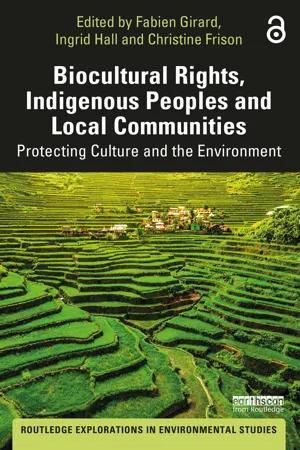
Biocultural Rights, Indigenous Peoples and Local Communities
Protecting Culture and the Environment
Fabien Girard, Ingrid Hall, Christine Frison, Fabien Girard, Ingrid Hall, Christine Frison
- 344 Seiten
- English
- ePUB (handyfreundlich)
- Über iOS und Android verfügbar
Biocultural Rights, Indigenous Peoples and Local Communities
Protecting Culture and the Environment
Fabien Girard, Ingrid Hall, Christine Frison, Fabien Girard, Ingrid Hall, Christine Frison
Über dieses Buch
This volume presents a comprehensive overview of biocultural rights, examining how we can promote the role of indigenous peoples and local communities as environmental stewards and how we can ensure that their ways of life are protected.
With Biocultural Community Protocols (BCPs) or Community Protocols (CPs)being increasingly seen as a powerful way of tackling this immense challenge, this book investigates these new instruments and considers the lessons that can be learnt about the situation of indigenous peoples and local communities. It opens with theoretical insights which provide the reader with foundational concepts such as biocultural diversity, biocultural rights and community rule-making. In Part Two, the book moves on to community protocols within the Access Benefit Sharing (ABS) context, while taking a glimpse into the nature and role of community protocols beyond issues of access to genetic resources and traditional knowledge. A thorough review of specific cases drawn from field-based research around the world is presented in this part. Comprehensive chapters also explore the negotiation process and raise stimulating questions about the role of international brokers and organizations and the way they can use BCPs/CPs as disciplinary tools for national and regional planning or to serve powerful institutional interests. Finally, the third part of the book considers whether BCPs/CPs, notably through their emphasis on "stewardship of nature" and "tradition", can be seen as problematic arrangements that constrain indigenous peoples within the Western imagination, without any hope of them reconstructing their identities according to their own visions, or whether they can be seen as political tools and representational strategies used by indigenous peoples in their struggle for greater rights to their land, territories and resources, and for more political space.
This volume will be of great interest to students and scholars of environmental law, indigenous peoples, biodiversity conservation and environmental anthropology. It will also be of great use to professionals and policymakers involved in environmental management and the protection of indigenous rights.
The Open Access version of this book, available at www.taylorfrancis.com, has been made available under a Creative Commons Attribution-Non Commercial-No Derivatives 4.0 license
Häufig gestellte Fragen
Information
1 Community Protocols and Biocultural Rights Unravelling the Biocultural Nexus in ABS
[…] term that covers a broad array of expressions, articulations, rules and practices generated by communities to set out how they expect other stakeholders to engage with them. They may reference customary as well as national or international laws to affirm their rights to be approached according to a certain set of standards. Articulating information, relevant factors, and details of customary laws and traditional authorities helps other stakeholders to better understand the community’s values and customary laws. Community protocols provide communities an opportunity to focus on their development aspirations vis-a-vis their rights and to articulate for themselves and for users their understanding of their bio-cultural heritage and therefore on what basis they will engage with a variety of stakeholders. By considering the interconnections of their land rights, current socio-economic situation, environmental concerns, customary laws and traditional knowledge, communities are better placed to determine for themselves how to negotiate with a variety of actors.2
The Context: “Traditional” Communities and Biodiversity Conservation
respect, preserve and maintain knowledge, innovations and practices of indigenous and local communities embodying traditional lifestyles relevant for the conservation and sustainable use of biological diversity and promote their wider application with the approval and involvement of the holders of such knowledge, innovations and practices.7
[…] the worldviews, knowledge, practices, and innovations embedded in the relationship between people and nature, as expressed in local knowledge about the natural world, techniques and technologies of resource management, as well as in local institutions governing social relations and relationship to nature.(IPBES, 2019, p. 37)
While local in action, IPLC management of nature and biodiversity provides contributions to the larger society, in rural and urban areas alike, includi...
Inhaltsverzeichnis
- Cover
- Half Title Page
- Series Page
- Title Page
- Copyright Page
- Table of Contents
- List of Illustrations
- Notes on Contributors
- Acknowledgements and Dedications
- Table of Cases and Legislation
- Acronyms and Abbreviations
- 1 Community Protocols and Biocultural Rights: Unravelling the Biocultural Nexus in ABS
- Part 1 Conceptual Insights: Biocultural Diversity, Biocultural Rights and Space Making
- Part 2 Biocultural Community Protocols, Access and Benefit-Sharing, and Beyond
- Part 3 Biocultural Jurisprudence, Sovereignty and Legal Subjectivity
- Index